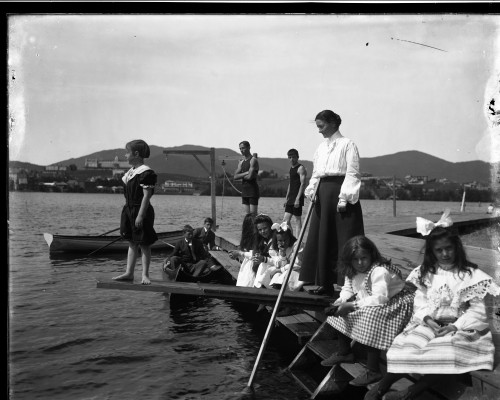By: Kayla Kempf
As we approach the middle of summer, I am feeling confident in my role as the Museum Assistant. My primary duties are working with the Historical Society’s collections and assisting with research. The Stedman and Moses Collection of Glass Plate Negatives are a large part of my collections work. I have a background working with museum collections, however I have never worked with glass plate negatives before this summer. I find the images on the negatives interesting and a fun way to learn the local history.
I have learned how to clean, scan, and input the images into our digital archiving program. This process has allowed me to familiarize myself with the negatives. Some of the most amusing and vibrant images have depicted summer activities. Myself, along with our summer volunteer Samantha Strzepek, have had the opportunity to curate a small exhibit in the Lake Placid Public Library. I would like to share some of my interesting discoveries and experiences working with the Stedman and Moses Collection of Glass Plate Negatives.
During the middle of the 19th century, visitors started to make their way up to the North Country. These visitors were those who had an interest in the outdoors and a taste for adventure. They were curious about the untouched, open landscape of the wild Adirondacks. Photographers Chester D. Stedman and Irving Lynn Moses captured fun leisure and athletic activities during every season with the use of their cameras.
Both Stedman and Moses worked for the Lake Placid Club, but in slightly different times. Chester D. Moses first arrived in Lake Placid in 1898. His photographs are mostly images of rustic camp interiors and exteriors around Lake Placid and Mirror Lake taken during the summers. Some of Moses’ most spectacular images captured views of Mirror Lake and the surrounding areas in a panoramic format.
He was the first official photographer of the Lake Placid Club. While supporting his medical studies, he built a large collection called “1,000 Adirondacks Views” to sell to the public. Photography was to play a continuous role into his professional career as he moved into photographic x-ray techniques and treatments in the First World War. Most of the large 8” x 10” glass plate negatives in the collection were taken by Chester D. Moses.
Irving Stedman was a working partner with Moses for some time and his photographs were taken after 1910. His work spanned all seasons in Lake Placid and were shot in the 5” x 7” format. Stedman took over the photography business as Moses found himself increasingly occupied by his medical practice. The majority of the collection are images taken by Stedman, who continued the business well into the 1930s.
During the summer months, visitors of Lake Placid would stay the entire season. Amongst the negatives, I have observed people indulging in their favorite summer activities. Photographs depict visitors enjoying water sports, such as swimming and canoeing. While others were interested in team sports or fishing and camping.
It is interesting to learn Lake Placid was seen as a peaceful getaway from busy cities and towns. Being new to the area, this is one of the aspects that attracted me to live in the Adirondacks. I too share the curious connection with this natural world. These summer photographs inspire me and my work at the History Museum. If you have the opportunity, I hope you will take the time to pop into the Library to view some of my favorite images from the collection.


